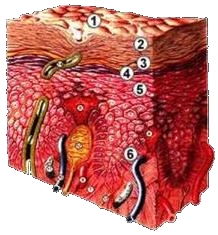Wir stehen jeden Tag auf, weil wir die besten Kunsttattoos der Welt machen wollen.
Quick Links
Unsere Kontaktdaten
Tattoo Bern & Tattooentfernungen ®
Giacomettistrasse 16, Bern
+41 78 215 00 55
[email protected]
The effects on the body and the skin can be serious, starting from burns to long-term damage and tattoo ink poisoning. The durability of the tattoo and the intensity of the color depend enormously on the quality of the ink. Therefore, it is highly recommended for everyone to be informed in advance which products and colors the studio uses.
Quality has its price – as with almost everything in life. For Lebende Legend, high quality is an absolute must. Our studio, therefore, uses only high-quality, tested and manufactured by authorized Swiss manufacturers.
All of the tattoo inks we use are of natural origin.
Human skin (lat. cutis) is the largest, heaviest and functionally most versatile organ in the human body. Our skin works like a defense shield. It serves to distinguish itself from inside and outside and protects us from all sorts of bacteria and germs but also from harmful environmental influences such as the UV rays of the sun. Simply stated, our skin consists of three layers called epidermis, dermis, and subcutis.

The epidermis itself consists of several layers (from the outside to the inside, see Fig.): • horny layer or stratum corneum (2) • clear layer or stratum lucidum (3) • granular layer (4) • spinous layer (5) • basal layer (6)
The epidermis is between 0.04mm and about 1.5mm thick. In a conventional tattoo, the color pigments of the tattoo color are incorporated through the epidermis into the dermis. The color pigments remain there without time limit and can only be removed by external influences (such as laser treatment).
In the case of an “organic tattoo”, the color pigments of the tattoo ink should only be worked into the epidermis. “Should”, because this is practically impossible! The epidermis is different in each person. Although everything that gets stuck in the epidermis lasts for a maximum of 30 days (namely a cell cycle) and disappears automatically after the renewal of the skin, everything that has penetrated deeper into the skin remains intact. Conclusion: It is impossible for a tattoo to go away by itself. Unfortunately, the truth is usually that a stained and irregular “something” remains in the skin. So stay away from Bio Tattoo – an absolute “no go”!
In order for your tattoo to heal properly, it is important that you follow the tattooist’s care instructions. Inadequate care can lead to unsightly scars, color irregularities and the like. If you’re unsure about anything, ask your tattoo artist again. Always remember that; a tattoo accompanies you for the rest of your life. Download the tattoo care instructions.
Time after tattooing | Care of the new tattoo |
After a day | Moisten the foil (best under the shower) and carefully remove it |
After one week | After removing the foil, moisturize the tattoo with a tattoo cream 2-3 times a day for a week |
After four weeks | In the first 4 weeks, you should refrain from a sunburn or solarium visit |
Worth knowing: The best way to remove the bandage is to moisten it with a cloth. The tattoo should not be rewrapped after removal of the dressing. (Let your skin breathe!) After the first 7 days of care, you should stop using cream, even if your skin is still dry after the eighth day. Over time, a crust will form on your tattoo, it should not be scraped off. When the time is right, it will fall off by itself. Should your tattoo itch, do not scratch it! If you still want to do something about it, just hold your hand on the tattoo or take cold water. Please avoid contact with animals during the healing phase.
Info: A tattoo is created by the penetration of organic pigments in the skin using fine needles. As a result of this skin injury, a crust forms after a few hours (as in the case of an abrasion). Under no circumstances should this crust be scratched, because otherwise these color pigments will be torn out of the fresh tattoo.
The healing of the tattoo is the sole responsibility of the customer.
Have you been to the Lebende Legend Instagram page? If not, then you should give us a visit!
Yes, there is such thing as tattoo pain. But how strong is it? Probably the most frequently asked question is:
“Does it hurt?”
Everyone can answer this question only for themselves. The personal sensation of pain varies greatly. Depending on the body, some are more sensitive and some are more insensitive. We know this even from everyday injuries. Some see tattoo pain as a slightly unpleasant scratching on the skin, while some compare it to stinging or pinching.
Anyone who gets a tattoo should be aware, however, that it is an intervention into the body. Of course there is a little pain, or else everyone would get henna instead.
Wir stehen jeden Tag auf, weil wir die besten Kunsttattoos der Welt machen wollen.
Tattoo Bern & Tattooentfernungen ®
Giacomettistrasse 16, Bern
+41 78 215 00 55
[email protected]